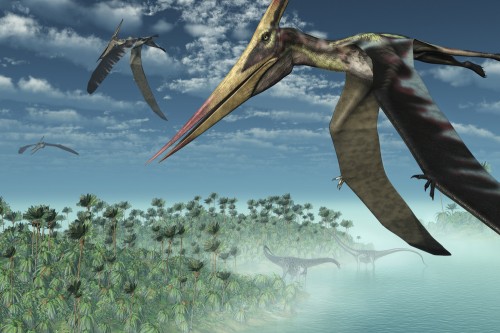Why is the US Department of Defense interested in pterosaurs, winged reptiles that ruled the skies 288 to 66 million years ago?

The paleontologist Michael Habib studies the biomechanics of pterosaurs, the largest of which, weighing about 250 kilograms and with a wingspan of about 10 meters, were similar in size to modern fighter planes. These were the largest flying animals that ever lived, and their anatomy was different from that of birds or bats. This makes them unique models for aviation mechanics, especially for large aircraft.
To understand how pterosaurs flew, Habib combined principles of physics and vertebrate anatomy with data from fossils. He hopes that from this knowledge NASA or the US Department of Defense will be able to design an aircraft with a new approach, as they have already done in some cases. In an abstract sense, Habib resurrected these animals. Here are some applications inspired by pterosaurs.
Robots flying in the sky of Mars
Traditional spacecraft would have to fly very fast to stay above the ground in the thin atmosphere of Mars, so they cannot serve as a practical solution for a detailed survey of the surface there. One of the possible solutions may be a robot that flies like a pterosaur: with wings that beat very quickly and a relatively slow body. Bees and hummingbirds also fly this way, and NASA has created robot models based on the biomechanics of such "fluttering flyers".
Shape-changing wings
Each pterosaur wing had a single pointed finger that grew up to 2.5 meters in length in the largest species. When the pterosaurs flew, these fingers bent when the wing was forced down, and straightened in a quick reflex when the wing came up. This spontaneous return to equilibrium saved pterosaurs a lot of energy during flapping. According to Habib, roboticists in the US Air Force are interested in shape-changing wings that could be used in airplanes as well as in parachutes, which are ultimately very convex wings.
Rapid take-off systems
The giant pterosaurs, unlike today's airplanes, did not need a runway. They were experts in vertical take-off, an operation that today's aircraft are unable to perform, or is very inefficient. Because reptiles had stiff, yet hollow and light bones, they were able to use their four limbs, both legs and wings, to push hard against the ground. This is how they managed to leap into the air, achieving high speed in a short distance. Habib is currently negotiating with the American Defense Advanced Research Projects Agency (DARPA) for a grant to design an aircraft with similar physical properties and a four-legged take-off method, with which the pilots will be able to take off vertically quickly and with little fuel consumption.
Tents that don't tip over
During flight, pterosaurs' wings remained stretched along their entire length. They were made of a membrane with long, thick fibers, interwoven with smaller fibers that controlled the degree of flapping of the wing. Each fiber on its own moved at high air pressure, but their different dimensions caused them to oscillate at opposite frequencies that eventually canceled each other out, and thus the entire wing remained stable. Habib approached tent manufacturers and offered them a design that utilizes the same physical principle to reduce noisy flapping and improve the stability of the tent in strong winds.
The article is published with the approval of Scientific American Israel

5 תגובות
Herzl
Regarding a transport plane (fighter planes in any case outside
to the field due to the lack of speed..) You are probably right,
But as far as I know there is no physical reason that drones
And even relatively large ones (or even ultra-light planes, all
The possibility has not yet been ruled out with certainty because of the acceleration) they won't be able to
Take off like the pterosaurs.
Nissim is right
After the development of the pens, the Russians bought quite a large number of such pens from the Americans.
Enough perpetuating this nonsense.
The paleontologist Habib wants to build an airplane with a four-legged take-off method - a bit delusional.
1. The acceleration at takeoff should be so great that the pilot breaks the joint.
2. The legs will have to be very long, the plane will not be able to carry their weight.
3. The plane will not have enough forward speed to create lift on the wings, so it will fall immediately.
4. One big advantage - Habib will receive the Ig-Nobel prize.
And by the way - Nissim is right. NASA bought the pens from FISHER PEN COMPANY at a price of $2.95 each. Anyone can buy a similar pen today as a souvenir. But it turns out that the company itself invested a lot of its money in development.
Nostradamus
The story about the pen and pencil is not true.
The ideas in the article have many uses for which helium balloons are probably not suitable.
The Americans invested millions of dollars in developing a pen that writes in space, the Russians used a pencil.
Why not use helium balloons with a motor or airships with helium? Why complicate what is not needed and spend on what is not needed instead of what is needed and keep important research away.